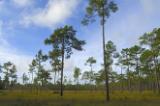 © Steve Vaughn/Panoramic Images (Florida Title Image Large)
© Steve Vaughn/Panoramic Images (Florida Title Image Large)

Longleaf Wiregrass in Florida
The longleaf pine/wiregrass ecosystem was once a dominant feature of the Southeastern Coastal Plain. It occupied vast areas of well-drained rolling hills in Florida, and included sandhill on high, xeric ridges and upland pine forest on hills with a clay subsoil. Sandhills and upland pine forests support canopies of tall longleaf pines (Pinus palustris) over a park-like understory of wiregrass (Aristida stricta), with widely scattered deciduous oaks (Quercus spp.). These species are well-adapted to fire and require frequent burns in order to maintain their dominance. In addition to supporting numerous rare plants, the longleaf pine/wiregrass ecosystem is critical habitat for many threatened and endangered animals, including red-cockaded woodpeckers (Picoides borealis) and gopher tortoises (Gopherus polyphemus).
The conversion of these natural communities to pine plantations, agricultural lands, residential areas and other types of development reduced the longleaf pine/wiregrass ecosystem in Florida by an estimated 90 percent from 1936 to 1995. Throughout the Southeast, only two percent of the original ecosystem remains in its natural condition. Large examples of these communities in Florida are now limited to a few publicly owned lands, including Blackwater River State Forest and Ocala National Forest.
Disruption of the natural fire regime, which historically occurred every one to three years, is a significant threat to the longleaf pine/wiregrass ecosystem. In the absence of frequent burns, invading oaks and other woody species create a shaded environment that eventually kills the wiregrass layer and inhibits the growth of longleaf pine seedlings. Once wiregrass disappears from a sandhill or upland pine forest it is difficult and costly to reestablish.
Florida Fish and Wildlife Conservation Commission Wildlife Legacy Initiative
Florida's Wildlife Legacy Initiative is our opportunity to conserve Florida’s wildlife and their habitats. The goal is to prevent wildlife from becoming endangered before they become more rare and costly to protect.
U.S. Fish and Wildlife Service Description of High Pine
Learn more about the longleaf pine/wiregrass ecosystem through the U.S. Fish and Wildlife Service Website.






